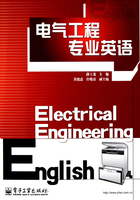
Lesson Three A.C.Generator
Synchronous A.C. generators for auxiliary supplies are usually of the type having a rotating field and with the armature winding on the stationary frame. Inverted constructions are also available and in this type the armature is rotating. Limitations in the size and complexity of the slip rings and brush-gears limit the invented construction to about 150 kVA.
On generators used for marine installations the field system may be of the salient-pole type in which the field-poles will be similar to those of a D.C. generator. Alternatively generators of the non-salient or cylindrical construction with distributed field windings embedded in slots may be used. The cylindrical type is generally used in high speed turbo-generators but some manufacturers now prefer them for all speed.
The physical size of the machine is influenced by the power factor of the system, and it is usual to base the rating on a power factor of 0.8 lagging which represents average operating conditions. The kVA rating is proportionately higher watts to be dissipated in the stator windings (usually referred to as the “copper losses”).
The power factor (p.f.) of the system is dependent on the type of load. Filament lighting, heating and cooking will be at unity power factor but induction motors, fluorescent lighting and transformers will take less than unity. Motors running at less than their full load rating will generally have a lower power factor than at full load, so the load current is not strictly proportional to the output. As it is desirable to keep the p.f. as high as possible it is therefore important not to install over-size motors. Cage type induction motors also have a very poor power factor which may be as low as 0.3~0.4, when starting, the current is 5~7 times the full load current.
The characteristic load-voltage current of an A.C. generator is very similar to that of a shunt wound D.C. generator, although the cause of the voltage drop is caused by stator resistance and by distortion of the flux path. With lagging power factors, there is a further loss of voltage caused by stator leakage reactance and by the fact that a component of stator m.m.f. has a directly demagnetizing action. The lower the p.f. the greater will these effects become.
In machines of normal design the drop between no load and full load with 0.8 p.f. will be of the order of 25%~35% , assuming constant excitation. In practice the voltage is restored to normal by increasing the excitation, and it will be seen that as the p.f. gets worse, more and more excitation is required, thus increasing the amount of heat dissipated in the field windings.
The behavior of an A.C. generator, when subject to transient load, e.g. starting comparatively large induction motors or when subject to short circuit, is somewhat complicated. There is an instantaneous voltage dip followed by recovery to a final steady state condition. The amount of dip is independent of partly heating and lighting and partly power. Too great a dip with too long a effects on the running of other motors and voltage sensitive equipment such as radar (if operated directly from the supply system) and on the starters for fluorescent lighting. The effect of p.f. of the transient loading on the transient as well as the steady state voltage regulation is important and it is necessary to take these conditions into account in the design of the machines.
New Words and Expressions
A.C.——alternating current交流电
synchronous[ˈsiŋkrənəs] adj. 同步的
rotate[rəuˈteit] vi. 转动,旋转
armature[ˈɑːmətjuə] n. 电枢,转子
stationary[ˈstei∫(ə)nəri] adj. 静止的
frame[freim] n. 构架,架,座,结构
invert[inˈvəːt] vt. 使反向
limitation[ˌlimiˈtei∫ən] n. 限制,局限
complexity[kəmˈpleksiti] n. 复杂
slip ring[slip riŋ] n. 花环
brush-gear[brʌ∫giə] n. 电刷装置
kVA——kilovolt ampere 千伏安
salient[ˈseiljənt] adj. 凸起的,显著的
nonsalient[ˈnɔnˈseiljənt] adj. 不凸起的
cylindrical[siˈlindrik(ə)l] adj. 圆柱体的
distribute[disˈtribju(ː)t] vt. 分配,分布
embed[imˈbed] vt. 把……嵌入
slot[slɔt] vt. 缝,槽
turbo-generator[ˈtəːbəuˈdʒenəreitə] n. 汽轮发电机
physical[ˈfizikəl] adj. 物理的,实际的
influence[ˈinfluəns] n. 影响,感化
lag[læg] vi. 滞后
represent [ˌriːpriˈzent] vt. 描绘,阐述,表示
proportionate [prəˈpɔː∫ənit] adj. 成比例的,相对的
dissipate[ˈdisipeit] vt. 浪费,使耗散
copper[ˈkɔpə] n. 铜
filament[ˈfiləmənt] n. 灯丝
unity[ˈjuːniti] n. 单一,整体
induction[inˈdʌk∫ən] n. 感应
fluorescent[fluəˈresənt] adj. 荧光的
strict[strikt] adj. 精确的
cage[keidʒ] n. 笼
distortion[disˈtɔː∫ən] n. 弄歪,变形,畸变
flux[flʌks] n. 磁通量
leakage[ˈliːkidʒ] n. 泄漏
reactance[riˈæktəns] n. 电抗
component[kəmˈpəunənt] n. 元件,组件,机件
m.m.f——magnetic-motive force 磁动势
demagnetize[diːˈmægnɪtaɪz] v. 使退磁
behavior[biˈheivjə] n. 性能,行为,特性
subject[ˈsʌbdʒikt] vt.;adj. 使受到;受支配的
transient[ˈtrænziənt] n.;adj. 瞬变的,瞬态值
somewhat[ˈsʌm(h)wɔt] adv. 有点
instantaneous[ˌinstənˈteinjəs] adj. 瞬间的,即刻的
dip[dip] n. 下降,下沉
objectionable[əbˈdʒek∫ənəbl] adj. 讨厌的,引起反对的
flicker[ˈflikə] n. 扑动,摇曳,闪烁
adverse[ˈædvəːs] adj. 相反的,不利的
sensitive[ˈsensitiv] adj. 灵敏的,敏感的
starter[ˈstɑːtə] n. 启动器
regulation [regjuˈlei∫ən] n. 调节
Notes
(1)…by the fact that a component of stator m. m. f. has a …
“fact”后面由“that”引导的是一个同位语从句。这种在复合句子中起同位语作用的从句通常由从属连词“that”引出。
例如:
1)The fact that electric currents passing through a wire produce heat is known to all.
电流通过导线时产生热这一事实是大家所知道的。
2)This experiment leads to the conclusion that unlike charges attract each other.
这个实验导致这样一个结论:异性电荷相吸。
(2)…“as well as…” 这是一个固定词组,as和well都失去了原有的词汇含义,这个词组起着一个并列连词的作用,意思是“以及,不仅……而且”。
值得注意的是,as well as用做并列连词时,着重的不是as well as之后的词,而是它之前的词,所以翻译的通常先译as well as之后的词,然后再翻译它之前的词。
例如:
Conductors and insulators are of great use in industry as well as in our daily life.
导体和绝缘体不仅在我们日常生活中有很大用处,而且在工业上也用处很大。
另外,当“as well as”用来连接两个主语时,其所谓动词应随前一个主语的人和数的变化而变化。
例如:
He as well as the other students has learned how to install this electric equipment.
他和其他学生一样也学会了如何安装这种电气设备。